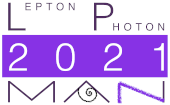Conveners
Dark Matter: Poster session
- There are no conveners in this block
Dark Matter: Parallel 1
- Darren Price (University of Manchester (GB))
Dark Matter: Parallel 2
- Teresa Marrodán Undagoitia
Dark Matter: 1
- Andrzej Michal Szelc (University of Manchester (GB))
Dark Matter: 2
- Ben Kilminster (University of Zurich (CH))
In this work, we investigate the beyond standard model (BSM) impact of leptophilic U(1) models, specifically $U(1)_{L_\mu-L_\tau}$ on coherent elastic neutrino-nucleus scattering (CE$\nu$NS) and hence its effect on dark matter (DM) direct detection experiments. Imposing the latest relevant experimental constraints on these models, we obtain $\mathcal{O}(50\%)$ enhancement for case of...
The Fermilab Muon $g-2$ experiment reported the results of its Run-1 measurement of the anomalous magnetic moment $a_\mu^{\textrm{FNAL}}$, which is in full agreement with the previous BNL measurement and pushes the world average deviation $\Delta a_\mu^{\text{2021}}$ from the Standard Model to a significance of $4.2\sigma$. In this talk I will present an extensive survey of its impact on...
Primordial black holes (PBHs), possibly formed via gravitational collapse of large density perturbations in the very early universe, are one of the earliest proposed and viable dark matter (DM) candidates. PBHs can make up a large or even entirety of DM density over a wide range of masses. Ultralight PBHs in the mass range of 10^{15} - 10^{17} g, emit particles via Hawking radiation, act as a...
Axion like particles(ALPs) and right handed neutrinos~(RHNs) are two well-motivated dark matter(DM) candidates. However, these two particles have a completely different origin. Axion was proposed to solve the Strong CP problem, whereas RHNs were introduced to explain light neutrino masses through seesaw mechanisms. We study the case of ALP portal RHN DM taking into account existing constraints...
The use of Convolutional Neural Networks (CNN) techniques has grown
widely among the Liquid Argon Time Projection Chamber (LArTPC) community, mainly because the high-resolution images produced by these detectors are
suitable to be processed by such neural networks. Current and future LArTPC
experiments are constantly investigating different applications of CNNs as is the
case in the...
LUX-ZEPLIN (LZ) is a dark matter direct detection experiment currently being commissioned at the Sanford Underground Research Facility in Lead, South Dakota. At the heart of the detector is a dual-phase time projection chamber containing 7 tonnes of active liquid xenon. During its 1000-day science run, LZ aims to achieve unprecedented sensitivity to Weakly Interacting Massive Particles (WIMPs)...
Liquid argon (LAr) is one of the most promising targets for the search of WIMP-like dark matter. LAr dual phase time projection chamber (LAr TPC) is a leading technology, able to detect both the scintillation and ionization signal. The correlation in the two signal channels provides a possible handle to measure the recoil direction of the nuclei: if confirmed, this would allow inferring the...
DarkSide run since mid 2015 a 50-kg-active-mass dual phase Liquid Argon Time Projection Chamber (TPC), filled with low radioactivity argon from an underground source and produced world class results for both the low mass ($M_{WIMP}<20GeV/c^2$) and high mass ($M_{WIMP}>100GeV/c^2$) direct detection search for dark matter.
The next stage of the DarkSide program will be a new generation...
The proposed LUXE experiment (LASER Und XFEL Experiment) at DESY, Hamburg, using the electron beam from the European XFEL, aims to probe QED in the non-perturbative regime created in collisions between high-intensity laser pulses and high-energy electron or photon beams. This setup also provides a unique opportunity to probe physics beyond the standard model. In this talk we show that by...
The Dark matter Experiment using Argon Pulseshape discrimination (DEAP) utilizes a single-phase liquid argon (LAr) detector aiming to acquire the scintillation light produced by nuclear recoils expected to be induced by Weakly Interacting Massive Particle (WIMP) candidate of dark matter. The DEAP-3600 detector consists of about 3.3 tonnes of LAr in a spherical acrylic vessel viewed by...
The Belle II experiment is in the unique position of probing a yet uncharted sector of particle physics, which includes hypothetical particles coupling very weekly with the standard model ones that might help explaining the nature of dark matter and other anomalies. Belle II analyzed 0.5 fb-1 of commissioning data to exclude part of the parameter space of models including low mass Z' bosons...
The presence of a non-baryonic Dark Matter (DM) component in the Universe is inferred from the observation of its gravitational interaction. If Dark Matter interacts weakly with the Standard Model (SM) it could be produced at the LHC. The ATLAS experiment has developed a broad search program for DM candidates, including resonance searches for the mediator which would couple DM to the SM,...
The FASER experiment is a new small and inexpensive experiment that is being placed 480 meters downstream of the ATLAS experiment at the CERN LHC. FASER is designed to discover dark photons and other light and very weakly-interacting particles that are produced in the far-forward region, outside of the ATLAS detector acceptance. The experiment has been successfully constructed and installed...
The constituents of dark matter are still unknown, and the viable possibilities span a very large mass range. Specific scenarios for the origin of dark matter sharpen the focus on a narrower range of masses: the natural scenario where dark matter originates from thermal contact with familiar matter in the early Universe requires the DM mass to lie within about an MeV to 100 TeV. Considerable...
In recent years the physics of Feebly Interacting Particles (FIPs) saw a growing interest as a possible solution to the Dark Matter issue [1]. FIPs are exotic and relatively light particles, not charged under the SM gauge group, whose interactions with the SM bosons or fermions are extremely suppressed. They are assumed to be part of a possible secluded sector, called the dark sector, with the...




